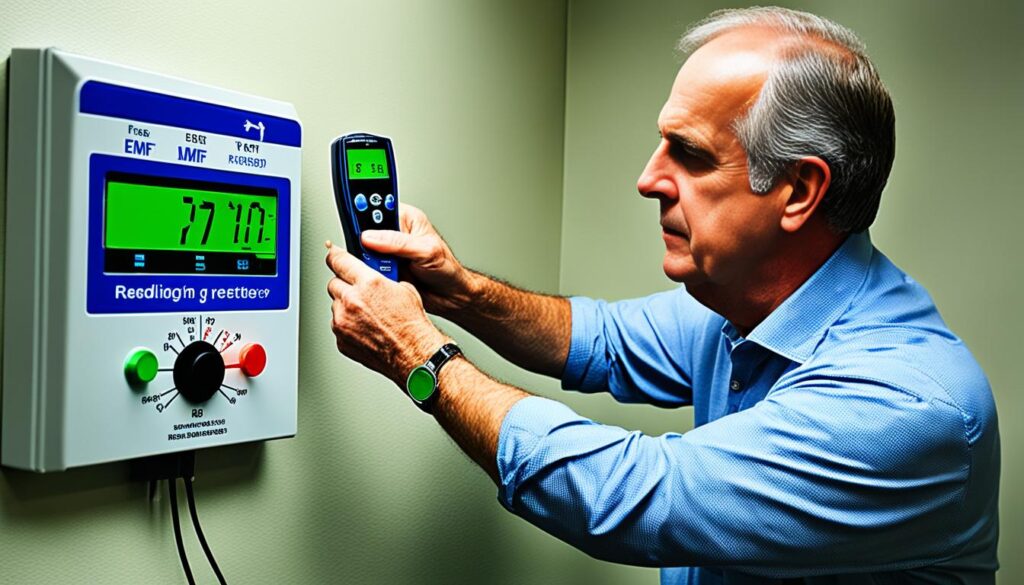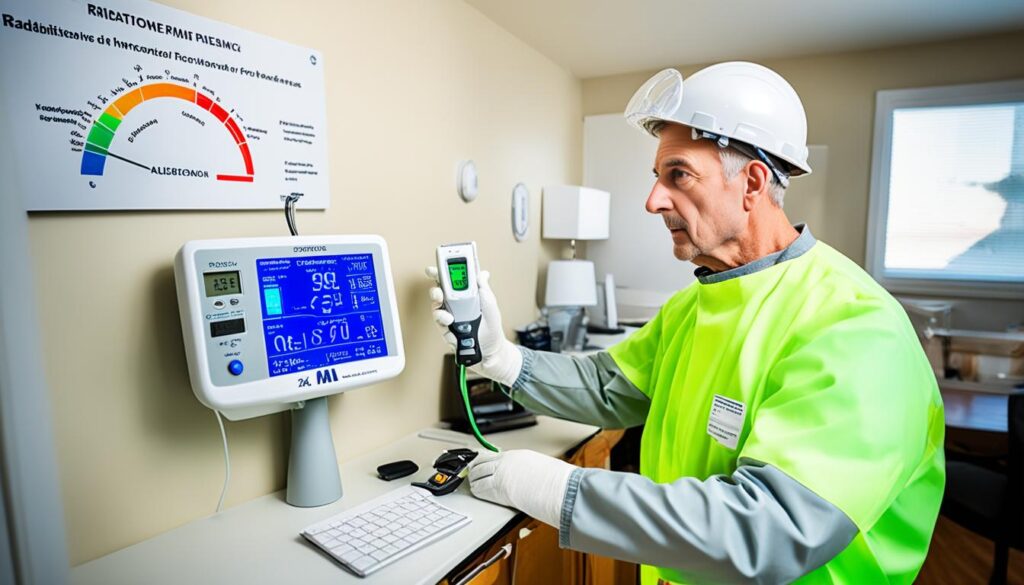Disclosure: This Post Contains Affiliate Links; We earn a commission on purchases.
Electromagnetic fields (EMFs) are all around us, emanating from many modern devices like microwaves, cell phones, and WiFi. While the scientific evidence regarding the health risks of EMFs is inconclusive, observational studies suggest that high-level EMF exposure could potentially have some adverse effects, such as lowered sperm count and neurological issues. Therefore, it is worth considering practical EMF protection measures to help reduce exposure and safeguard our health.
Key Takeaways:
- EMFs are electromagnetic fields that radiate from electrical sources and can potentially contribute to health problems.
- While scientific evidence regarding the health risks of EMFs is inconclusive, observational studies suggest potential adverse effects with high-level exposure.
- Practical EMF protection strategies include increasing distance from EMF sources, turning off or reducing device usage, and using shielding techniques.
- Measuring EMF levels using affordable EMF meters can provide valuable information about personal exposure.
- Personal choices, such as keeping a safe distance from wireless devices and reducing unnecessary device usage, play a significant role in reducing overall EMF exposure.
Understanding EMFs: What Are They and Their Potential Impact
Electromagnetic fields (EMFs) are invisible areas of energy that radiate from sources of electrical power and from natural and man-made light sources. These fields consist of electric and magnetic waves that oscillate at specific frequencies. EMFs are classified into two categories: non-ionizing and ionizing. Non-ionizing EMFs, which are the focus of this article, come from common devices such as microwaves, computers, cell phones, and power lines.
While scientific evidence regarding the health risks of EMFs is inconclusive, there is some potential for EMFs to contribute to health problems. Studies have suggested a possible link between high-level EMF exposure and conditions like cancer, reproductive issues, and neurological disorders. However, it’s important to note that the overall quality of scientific research in this area is weak, and more rigorous studies are needed to establish a clear cause-and-effect relationship.
The National Institute of Environmental Health Sciences acknowledges the current limitations of research but advises individuals to take practical steps to limit exposure to EMFs. This includes reducing the use of devices that emit EMFs, maintaining a safe distance from sources, and using shielding techniques when possible.
Measuring EMF exposure is also possible using affordable EMF meters. These devices allow individuals to assess their own levels of exposure and make informed decisions about minimizing risks. By monitoring EMF levels, individuals can identify areas of concern and take appropriate measures to reduce their exposure.
It is important to note that despite the inconclusive evidence, taking precautionary measures to reduce EMF exposure may help individuals feel more at ease and potentially support overall well-being.
By understanding the nature of EMFs and their potential impact on health, individuals can make informed choices to minimize their exposure and promote a healthier environment for themselves and their families.
Practical Tips for Reducing EMF Exposure at Home
Reducing your exposure to electromagnetic fields (EMFs) at home is an important step in safeguarding your health and well-being. By implementing simple and practical measures, you can minimize your EMF exposure and create a safer living environment for you and your family.
Keep a Distance from EMF Sources
One of the most effective ways to reduce EMF exposure is by maintaining a safe distance from EMF sources. Some common sources of EMFs in the home include WiFi routers, screens, and electrical outlets. By keeping a distance from these sources, you can significantly lower your exposure levels.
Additional tips for maintaining distance from EMF sources:
- Move beds and seating areas away from electrical outlets.
- Place WiFi routers in central areas of the home, away from frequently occupied rooms.
- Limit the time spent near electronic devices, such as laptops and tablets.
Turn Off or Unplug Devices When Not in Use
Even when devices are not actively in use, they can still emit EMFs. By turning off or unplugging devices when they are not needed, you can reduce your overall exposure. This simple practice can make a significant difference in minimizing your EMF levels.
Here are some examples of devices to turn off or unplug when not in use:
- Televisions
- Computers and laptops
- Microwaves
- Cordless phones
- Gaming consoles
Utilize Shielding Techniques
Using shielding techniques can further reduce your exposure to EMFs and create a more EMF-free environment within your home. Shielding materials can block or redirect EMFs, providing an additional layer of protection.
Consider the following shielding techniques:
- Use EMF-protective cases for cell phones and tablets.
- Utilize curtains or window films infused with EMF-blocking materials.
- Opt for analog or battery-operated appliances instead of electric ones.
Regularly Check EMF Levels
It is essential to prioritize checking EMF levels in areas of your home where you spend the most time. This will help you identify areas with higher exposure and guide you in prioritizing reduction measures.
Consider using an affordable EMF meter to measure and monitor your exposure. This tool will provide you with valuable information and enable you to make informed decisions about reducing EMFs in your living spaces.
| Location | EMF Levels (mG) |
|---|---|
| Living Room | 0.5 |
| Bedroom | 0.2 |
| Kitchen | 0.8 |
Table: Example of EMF Levels in Different Areas of the Home
By regularly monitoring EMF levels in your home, you can take targeted actions to reduce exposure and create a healthier living environment.
Remember, reducing EMF exposure at home involves a combination of practical steps, personal choices, and awareness. By implementing these tips, you can proactively reduce your exposure and prioritize your health and well-being.
The Link Between EMFs and Health Conditions
While the scientific evidence linking EMFs to specific health conditions is weak, there are certain conditions that have been associated with EMF exposure. These include potential effects on sperm count and motility, as well as neurological issues. However, it is important to note that the research in this area is still evolving and more studies are needed to establish a clear cause-and-effect relationship. Additionally, some individuals may experience symptoms of EMF hypersensitivity, which are subjective and not fully understood.
“It is recommended to consult a healthcare professional for personalized advice if experiencing severe symptoms related to EMF exposure.”
Despite the limited evidence, it is crucial to stay informed about potential health risks and take appropriate precautions to minimize exposure. With ongoing research and developments, a deeper understanding of the connection between EMFs and health conditions may emerge in the future. In the meantime, maintaining a balanced and informed approach to EMF exposure can help protect our well-being.
Conditions Associated with EMF Exposure
While the evidence is inconclusive, some studies have suggested a possible link between EMF exposure and certain health conditions:
- Effects on sperm count and motility: Some research has shown a potential impact of EMFs on male fertility, including reduced sperm count and decreased sperm motility.
- Neurological issues: There is some evidence that EMFs could have neurological effects, although the research is still preliminary. Some studies have suggested a possible association with symptoms such as headaches, fatigue, and cognitive impairment.
It is important to approach these findings with caution, as more high-quality research is needed to establish clear causation between EMF exposure and these specific conditions. The interaction between EMFs and human health is a complex area that requires further exploration.
The Importance of EMF Distance and Measurement
When it comes to reducing EMF exposure, distance plays a critical role. The farther away individuals are from EMF sources, the lower their exposure. Measuring EMF levels using affordable meters can provide individuals with valuable information about their exposure and help them identify areas where reduction measures may be needed.
The inverse-square law explains how EMF intensity diminishes with distance from the source. This means that as you move away from an EMF source, the intensity of the field decreases rapidly. By increasing the distance between yourself and the source, you can significantly reduce your exposure to EMFs.
It is important to note that the safety levels recommended by experts vary, and individual sensitivity to EMFs also plays a role. While some individuals may be more sensitive to EMFs, keeping a safe distance from EMF sources is generally considered a practical measure for reducing exposure.
EMF Measurement and Monitoring
To accurately assess your EMF exposure, it is essential to measure the levels in your environment. This is where EMF meters come in handy. These devices allow you to measure the strength of the electromagnetic fields around you and determine if they are within acceptable limits.
EMF meters are affordable and easy to use. They provide valuable insights into the levels of EMFs emitted by different devices and areas in your home or workplace. By measuring EMFs, you can identify “hotspots” where the exposure is high and take steps to mitigate the risks.
When using an EMF meter, it’s important to follow the manufacturer’s instructions and understand the measurement units displayed. Some common units used for EMF measurement include milligauss (mG) for magnetic fields and volts per meter (V/m) for electric fields.
Regular monitoring using an EMF meter allows you to track your exposure over time and make informed decisions about your environment. It empowers you to create a safer and healthier space for yourself and your loved ones.

Table: Recommended Maximum Exposure Limits for EMFs
| EMF Type | Maximum Exposure Limit |
|---|---|
| Magnetic Fields (Power Lines, Appliances) | 2 milligauss (mG) |
| Electric Fields (Wiring, Devices) | 10 volts per meter (V/m) |
| Radiofrequency (Cell Phones, Wi-Fi) | 1,000 microvolts per meter (µV/m) |
It is important to note that these exposure limits may vary depending on the country and regulatory guidelines. Consulting local authorities or EMF experts can provide you with more specific information for your location.
EMF Protection: The Role of EMF Meters and Personal Choices
Assessing and monitoring EMF levels is crucial in protecting ourselves from potential risks. EMF meters are powerful tools that enable individuals to make informed decisions about their exposure and take necessary steps to reduce it. Investing in an EMF meter can provide invaluable insight into the EMF levels in different environments, allowing for targeted protection measures.
However, personal choices also play a significant role in EMF protection. By implementing simple actions and habits, individuals can further reduce their overall EMF exposure and safeguard their well-being.
Keeping a safe distance from wireless devices is a fundamental step in minimizing EMF exposure. This includes maintaining a reasonable distance from cell phones, laptops, and other devices whenever possible. Switching to hands-free options for cell phone calls can also limit direct EMF exposure to the head and body.
Additionally, actively reducing the use of devices when not needed can significantly lower EMF exposure. Turning off devices or putting them on airplane mode during sleep or quiet hours can provide a respite from continuous exposure.
While personal choices are essential, it is vital to strike a balance between enjoying the benefits of modern devices and taking practical steps to minimize potential risks. By incorporating these simple habits and utilizing the insights provided by EMF meters, individuals can make conscious choices to protect themselves and their loved ones.
The Importance of Regular EMF Assessments
Regularly assessing EMF levels is crucial for maintaining effective protection measures. EMF levels can vary over time, especially in dynamic environments such as workplaces or homes near high-power lines. By periodically measuring EMF levels with an EMF meter, individuals can identify potential areas of concern and implement necessary protection strategies.
Here is an example of how EMF assessments can be beneficial:
| EMF Assessment Results in Different Environments | EMF Levels (mV/m) |
|---|---|
| Living Room | 10 |
| Bedroom | 5 |
| Office | 15 |
Based on the assessment results above, an individual might choose to prioritize EMF protection measures in their office, where the levels are higher. By implementing strategies to reduce EMF exposure in areas with higher levels, individuals can create safer environments for themselves and their families.

By combining the insights gained from EMF meters with personal choices and protection habits, individuals can take an active role in reducing their exposure to electromagnetic fields.
“EMF meters provide a valuable tool for understanding and managing EMF exposure. Monitoring exposure levels empowers individuals to take control of their health and well-being.” – Dr. Jane Nelson, EMF Researcher
While the scientific community continues to study the long-term effects of EMF exposure, taking proactive steps to minimize potential risks is a wise approach. Through a combination of EMF assessments, personal choices, and protection strategies, individuals can create healthier environments and enjoy the benefits of technology with greater peace of mind.
Conclusion
While the scientific evidence regarding the health risks of electromagnetic fields (EMFs) is inconclusive, there are practical EMF solutions that individuals can implement to reduce their exposure and safeguard their health.
By adopting simple strategies such as increasing distance from EMF sources, turning off or reducing device usage, and employing shielding techniques, individuals can minimize their potential risks associated with EMF exposure.
It is important to note that personal choices and risk assessments may vary, as different individuals have different sensitivities and tolerances to EMFs. Finding a balance between the use of modern devices and EMF protection is key. By staying informed about the latest research and taking proactive steps, individuals can prioritize their health while still enjoying the benefits of technology.
Source Links
- https://greenbeanbookspdx.indielite.org/book/9781732365056
- https://drruscio.com/emf-protection/
- https://techwellness.com/blogs/expertise/emf-protection-basics-how-to-reduce-your-emf-exposure-stop-tech-from-making-you-sick

Subscribe to Our Newsletter










